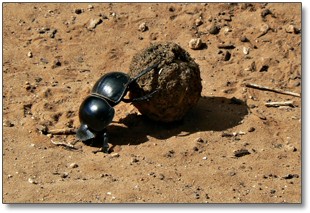Dung Beetles Reach for the Stars
By Shubhangi Chouhan
They may be tiny and always down in dirt, but they also keep their eyes on the stars.
Dung beetles are a species dependent on feces for their nutrition and breeding. They shape piles of dung in small balls, use their hind legs to roll them away from competitors and bury them underground to feed their young.
The beetles roll the dung balls using their hind legs and, if they don’t roll in a straight line, they risk circling back to their competitors. How they manage to maintain a straight course on a moonless night â without any set landmarks â is the subject of a new study.
The Straight and Narrow Path
Dung beetles are known to follow a linear path using visual cues from celestial bodies such as the sun, the moon or the pattern of polarized light that creates a compass around them.
The beetles don’t need to roll perfectly in-line with the Milky Way, although they use its natural light as a reference. Vision scientist Marie Dacke and her colleagues at Lund University in Sweden studied this behavioral pattern by tracking a group of African dung beetles.

Photo credit: Kay-Africa via Wikimedia Commons
The beetles and their dung balls were put in the middle of sandy area surrounded by a meter-high wall and no landmark on the ground. An overhead camera recorded their movements. Although the tiny compound eyes are too weak to distinguish individual planets or stars, when the moon and the stars were clearly visible, the path they made was almost straight. Even on a moonless night they efficiently used the light-to-dark gradient of the Milky Way to roll dung in straight paths. But with an overcast sky, the insects rolled the dung aimlessly.
When masking blinders were used on these beetles, they were still able to orient themselves using the Milky Way, proving that they are the first species of their kind to find their way around using a visual compass system rather than landmarks.
Other Nocturnal Navigators
Scientist theorize that frogs, spiders and other nocturnal critters also use the stars, the Milky Way and polarized moonlight for orientation but they have yet to conduct studies to prove it.
Classroom Discussion
- Do you know of any more species with such special navigation/orientation abilities?
- How might light pollution affect dung beetles and the role they play in sustaining the ecosystem?
